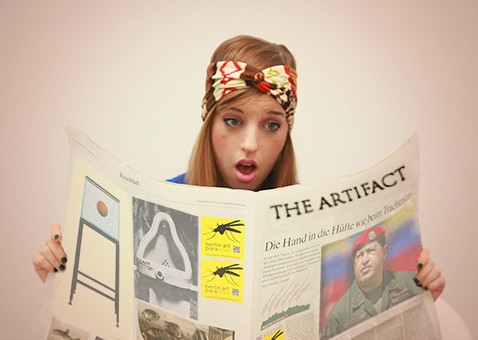wanderlust
Death At A Urinal

Note from the Editor: “The Artifact” is not your conventional news source—mainly because it is not a news source at all. What this weekly Sunday article provides is a platform where world events are juxtaposed with works of art, finding reflections and similarities in the often-frictional relationship between the “real world” and the “art world.” It is the case that most works of art, abstract or representative, tend to imitate life or an aspect of it. The Artifact, complementarily, seeks to find life situations that imitate works of art already made.
From The Loo To The Louvre
POLITICS––The flamboyantly provocative president of Venezuela died this past Tuesday. Hugo Chávez was fifty-eight and had led the Latin American country for the past fourteen years. Diagnosis: his body surrendered after a two-year long battle with cancer. But it is the polarized reaction to his death, depending on whom you ask or what media outlet you read, that has caught my attention.
On the left, his supporters are mourning the death of a liberator and revolutionary who championed the poor and challenged the neo-imperialistic policies of the United States. On the right, the scene is much more cheerful.
Which, as if it weren’t already obvious, brings us to French artist Marcel Duchamp’s urinal, or “Fountain.”

“Fountain” is a work that, since 1917, has championed the poor. Actually, let me expand on that sentence: it is a work of art that has championed the poor of artistic skill. This urinal, flipped on its back like an incapacitated turtle, is widely regarded as the symbolic birth of conceptual art. No, Marcel did not actually sculpt it and no, he did not design it either. His revolutionary act, instead, was to take an already made urinal from its original location, sign it and call it art. Since then, this mischievous act has snowballed to become “the most influential modern art work of all time.”
Where Hugo Chávez and “Fountain” intertwine, however, is not in their mischievous nature but in the divide they have established—each in their own fields—between the left and the right. On the left, you have the supporters of Duchamp’s urinal who applaud the liberation of art from the imperialistic claws of skill and talent––claws of the then-eliteSociety of Independent Artists to whom Duchamp submitted this work: the self-proclaimed avant-garde. After “Fountain,” the means of production of art acquired a socialist twist: art was no longer delegated to the most seasoned hand but to the most seasoned mind. It introduced banal, everyday objects into the almost sacred spaces in which oil paintings hung and marble sculptures rested and, to spite bourgeois society, sought for art to became a language of the common people. In short, “Fountain” proudly dictated that anything could be art and, likewise, anyone could be an artist—a thought that continues to give shudders to those who still cling to the centuries old notion that art belongs to those with manual dexterity and talent.
Yet, things appear better in hindsight, and while Duchamp’s “Fountain” has already reserved its place in the history books, we’ll have to wait and see what history does with the name Hugo Chávez. Today the answer still depends on who you ask.
| Continued On Page 2 |
Be the first to write a comment.
Your feedback
